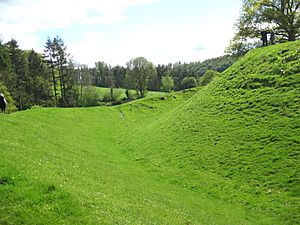Sycharth facts for kids
Quick facts for kids Sycharth Motte and Bailey Castle |
|
|---|---|
| Llansilin, Montgomeryshire, Wales | |

Sycharth from field, showing motte
|
|
| Coordinates | 52°49′28″N 3°10′51″W / 52.824498°N 3.180842°W |
| Site information | |
| Owner | Cadw guardianship |
| Condition | Grass covered mound with banks and outer bailey. |
| Site history | |
| Built | Norman Period |
| Materials | Timber Castle |
| Demolished | 1403 |
| Events | Revolt of Owain Glyndŵr (1400–09) |
Sycharth is the site of an old castle and a small town in Llansilin, Powys, Wales. It is a special kind of castle called a motte and bailey castle. Sycharth Castle is famous because it was the birthplace of Owain Glyndŵr, a very important Welsh leader.
Contents
Where is Sycharth Castle?
Sycharth is located in a valley near the Cynllaith river. The castle site is about one kilometer (half a mile) from the border between England and Wales. There is a wooded area nearby called Parc Sycharth. Next to the castle site is a farm that used to be a courthouse.
You can find Sycharth on a small road close to the B4580. It is south of Llansilin and southwest of Oswestry. The site is looked after by Cadw, a Welsh government body. There is a small car park and information boards for visitors.
History of Sycharth Castle
Sycharth Castle was built in a Welsh area known as Powys Fadog. After the Normans took over England, they also gained control of parts of Wales. It is believed that the Normans built Sycharth as a motte and bailey castle. This likely happened before the year 1086.
Later, the castle came into the hands of Welsh leaders. Around the year 1275, a man named Madog Crypl became the lord of this area. Owain Glyndŵr was a descendant of these Welsh princes. Owain Glyndŵr inherited Sycharth in 1369. He lived there with his wife, Margaret Hanmer, and their children.
What Sycharth Looked Like
A Welsh poet named Iolo Goch wrote about Sycharth. He described it as having "nine plated buildings" that looked like "eighteen mansions." He said there were "fair wooden buildings on top of a green hill." The poet also mentioned "a tiled roof on every house" and "a chimney from which the smoke would grow." He saw "nine symmetrical, identical halls" with "nine wardrobes by each one." This suggests it was a large and impressive home for Owain Glyndŵr.
What We Know from Digs
Archaeologists dug at Sycharth in the early 1960s. They found signs of two large wooden halls on the flat top of the castle mound. One of these halls was 43 meters (about 140 feet) long. The digs also showed evidence that the site had been burned.
How Sycharth Was Destroyed
Sycharth Castle was destroyed in May 1403. Prince Henry, who later became King Henry V, led an attack on the castle. He wrote a letter to his father, King Henry IV, on May 15, 1403.
In his letter, Prince Henry said that his soldiers went to Owain Glyndŵr's main home, Sycharth. They hoped to find him there, but he was not present. So, they "caused the whole place and many of his other houses of his tenants in the neighbourhood to be burnt." After that, they went to another of Owain's places and burned a lodge in his park.
Today, Sycharth is a grass-covered mound with banks. It shows where the castle once stood.
Images for kids











